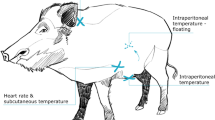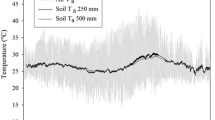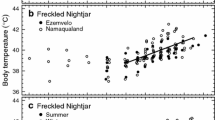Abstract
Columbid birds represent a useful model taxon for examining adaptation in metabolic and thermal traits, including the effects of insularity. To test predictions concerning the role of insularity and low predation risk as factors selecting for the use of torpor, and the evolution of low basal metabolic rate in island species, we examined thermoregulation under laboratory and semi-natural conditions in a mainland species, the African Green Pigeon (Treron calvus). Under laboratory conditions, rest-phase body temperature (T b) was significantly and positively correlated with air temperature (T a) between 0 and 35 °C, and the relationship between resting metabolic rate (RMR) and T a differed from typical endothermic patterns. The minimum RMR, which we interpret as basal metabolic rate (BMR), was 0.825 ± 0.090 W. Green pigeons responded to food restriction by significantly decreasing rest-phase T b, but the reductions were small (at most ~5 °C below normothermic values), with a minimum T b of 33.1 °C recorded in a food-deprived bird. We found no evidence of the large reductions in T b and metabolic rate and the lethargic state characteristic of torpor. The absence of torpor in T. calvus lends support to the idea that species restricted to islands that are free of predators are more likely to use torpor than mainland species that face the risk of predation during the rest-phase. We also analysed interspecific variation in columbid BMR in a phylogenetically informed framework and verified the conclusions of an earlier study which found that BMR is significantly lower in island species compared to those that occur on mainlands.






Similar content being viewed by others
References
Anderson KJ, Jetz W (2005) The broad-scale ecology of energy expenditure of endotherms. Ecol Lett 8:310–318
Baker WC, Pouchot JF (1983) The measurement of gas flow. Part II. J Air Pollut Control Assoc 33:156–162
Baptista LF, Trail PW, Horblit HM (1997) Family Columbidae (pigeons and doves). In: del Hoyo J, Elliot A, Sargatal J (eds) Handbook of the birds of the world vol 4 Sandgrouse to cuckoos. Lynx Edicions, Barcelona, pp 60–243
Bauer AM, Vindum JV (1990) A checklist and key to the herpetofauna of New Caledonia, with remarks on biogeography. Proc Calif Acad Sci 47:17–45
Blomberg SP, Garland T, Ives AR (2003) Testing for phylogenetic signal in comparative data: behavioral traits are more labile. Evolution 57:717–745
Blondel J, Dias PC, Perret P, Maistre M, Lambrechts MM (1999) Selection-based biodiversity at a small spatial scale in a low-dispersing insular bird. Science 285:1399–1402
Boyles JG, Smit B, McKechnie AE (2011) A new comparative metric for estimating heterothermy in endotherms. Physiol Biochem Zool 84:115–123
Brigham RM, McKechnie AE, Doucette LI, Geiser F (2012) Heterothermy in caprimulgid birds: a review of inter- and intraspecific variation in free-ranging populations. In: Ruf T, Bieber C, Arnold W, Millesi E (eds) Living in a seasonal world: thermoregulatory and metabolic adaptation. Springer, Heidelberg, pp 175–187
Clegg SM, Degnan SM, Moritz C, Estoup A, Kikkawa J, Owens IPF (2002) Microevolution in island forms: the roles of drift and directional selection in morphological divergence of a passerine bird. Evolution 56:2090–2099
Cory Toussaint D, McKechnie AE (2012) Interspecific variation in thermoregulation among three sympatric bats inhabiting a hot, semi-arid environment. J Comp Physiol B 182:1129–1140
Cowles GS, Goodwin D (1959) Seed digestion by the fruit-eating pigeon Treron. Ibis 101:253–254
Daan S, Masman D, Groenewold A (1990) Avian basal metabolic rates: their association with body composition and energy expenditure in nature. Am J Physiol 259:R333–R340
Dawson WR, Whittow GC (2000) Regulation of body temperature. In: Sturkie PD (ed) Avian physiology. Academic Press, New York, pp 343–390
Dean WRJ (2005) African Green-Pigeon. In: Hockey PAR, Dean WRJ, Ryan PG (eds) Roberts birds of southern Africa. The Trustees of the John Voelcker Bird Book Fund, Cape Town
Downs CT, Brown M (2002) Nocturnal heterothermy and torpor in the Malachite sunbird (Nectarinia famosa). Auk 119:251–260
Felsenstein J (1985) Phylogenies and the comparative method. Am Nat 125:1–15
Geiser F (1993) Metabolic rate reduction during hibernation. In: Carey C, Florant GL, Wunder BA, Horwitz B (eds) Life in the cold: ecological, physiological and molecular mechanisms. Westview Press, Boulder
Geiser F (2004) Metabolic rate and body temperature reduction during daily torpor. Ann Rev Physiol 66:239–274
Geiser F, Holloway JC, Körtner G, Maddocks TA, Turbill C, Brigham RM (2000) Do patterns of torpor differ between free-ranging and captive mammals and birds? In: Heldmaier G, Klingenspor M (eds) Life in the cold: 11th international hibernation symposium. Springer, Berlin, pp 95–102
Genz A, Bretz F, Miwa T, Mi X, Leisch F, Scheipl F, Hothorn T (2011) mvtnorm: Multivariate normal and t distributions. R package version 0.9-9991
Gibb GC, Penny D (2010) Two aspects along the continuum of pigeon evolution: a South-Pacific radiation and the relationship of pigeons within Neoaves. Mol Phylogenet Evol 56:698–706
Gibbs D, Barnes E, Cox J (2001) Pigeons and doves: a guide to the pigeons and doves of the world. Christopher Helm Publishers, London
Goodwin D (1983) Pigeons and doves of the world. Cornell University Press, Ithaca
Grant PR (1968) Bill size, body size, and the ecological adaptations of bird species to competitive situations on islands. Syst Biol 17:319–333
Hackett SJ, Kimball RT, Reddy S, Bowie RCK, Braun EL, Braun MJ, Chojnowski JL, Cox WA, Han K-L, Harshman J, Huddleston CJ, Marks BD, Miglia KJ, Moore WS, Sheldon FH, Steadman DW, Witt CC, Yuri T (2008) A phylogenomic study of birds reveals their evolutionary history. Science 320:1763–1768
Heldmaier G, Ruf T (1992) Body temperature and metabolic rate during natural hypothermia in endotherms. J Comp Physiol 162:696–706
Hothorn T, Bretz F, Westfall P (2008) Simultaneous inference in general parametric models. Biometr J 50:346–363
Jensen C, Bech C (1992a) Oxygen consumption and acid-base balance during shallow hypothermia in the pigeon. Respir Physiol 88:193–204
Jensen C, Bech C (1992b) Ventilation and gas exchange during shallow hypothermia in pigeons. J Exp Biol 165:111–120
Jetz W, Freckleton RP, McKechnie AE (2008) Environment, migratory tendency, phylogeny and basal metabolic rate in birds. PLoS ONE 3:e3261
Jetz W, Thomas GE, Joy JB, Hartmann K, Mooers AO (2012) The global diversity of birds in space and time. Nature 491:444–448
Karasov WH (1990) Digestion in birds: chemical and physiological determinants and implications. In: Morrison ML, Ralph CJ, Verner J, Jehl JR (eds) Studies in avian biology No 13. Cooper Ornithological Society, Los Angeles, pp 391–415
Kendeigh SC, Dol’nik VR, Gavrilov VM (1977) Avian energetics. In: Pinowski J, Kendeigh SC (eds) Granivorous birds in ecosystems. Cambridge University Press, Cambridge, pp 129–204
Lambert LR (1989) Pigeons as seed predators and dispersers of figs in a Malaysian lowland forest. Ibis 131:521–527
Lasiewski RC, Acosta AL, Bernstein MH (1966) Evaporative water loss in birds-I. Characteristics of the open flow method of determination, and their relation to estimates of thermoregulatory ability. Comp Biochem Physiol 19:445–457
Laurila M, Hohtola E (2005) The effect of ambient temperature and simulated predation risk on fasting-induced nocturnal hypothermia of pigeons in outdoor conditions. J Therm Biol 30:392–399
Lavin SR, Karasov WH, Ives AR, Middleton KM, Garland T (2008) Morphometrics of the avian small intestine compared with that of nonflying mammals: a phylogenetic approach. Physiol Biochem Zool 81:526–550
Lighton JRB (2008) Measuring metabolic rates: a manual for scientists. Oxford University Press, Oxford
Lovegrove BG (2000) The zoogeography of mammalian basal metabolic rate. Am Nat 156:201–219
MacMillen RE, Trost CH (1967) Nocturnal hypothermia in the inca dove Scardafella inca. Comp Biochem Physiol 23:243–253
Maddison WP, Maddison DR (2011) Mesquite: a modular system for evolutionary analysis. Version 2.75. http://mesquiteproject.org
Maldonado KE, Cavieres G, Veloso C, Canals M, Sabat P (2009) Physiological responses in rufous-collared sparrows to thermal acclimation and seasonal acclimatization. J Comp Physiol B 179:335–343
Matson KD (2006) Are there differences in immune function between continental and insular birds? Proc R Soc B 273:2267–2274
McKechnie AE (2008) Phenotypic flexibility in basal metabolic rate and the changing view of avian physiological diversity: a review. J Comp Physiol B 178:235–247
McKechnie AE, Lovegrove BG (2002) Avian facultative hypothermic responses: a review. Condor 104:705–724
McKechnie AE, Lovegrove BG (2003) Facultative hypothermic responses in an Afrotropical arid-zone passerine, the red-headed finch (Amadina erythrocephala). J Comp Physiol B 173:339–346
McKechnie AE, Lovegrove BG (2006) Evolutionary and ecological determinants of avian torpor: a conceptual model. Acta Zool Sinica 52(suppl.):409–413
McKechnie AE, Mzilikazi N (2011) Heterothermy in Afrotropical birds and mammals: a review. Int Comp Biol 51:349–363
McKechnie AE, Smit B (2010) Thermoregulation under seminatural conditions in two species of African barbets (Piciformes: Lybiidae). Ostrich 81:97–102
McKechnie AE, Wolf BO (2010) Climate change increases the likelihood of catastrophic avian mortality events during extreme heat waves. Biol Lett 6:253–256
McKechnie AE, Chetty K, Lovegrove BG (2007) Phenotypic flexibility in basal metabolic rate in Laughing Doves: responses to short-term thermal acclimation. J Exp Biol 210:97–106
McNab BK (1994) Energy conservation and the evolution of flightlessness in birds. Am Nat 144:628–642
McNab BK (2000) The influence of body mass, climate, and distribution on the energetics of South Pacific pigeons. Comp Biochem Physiol A 127:309–329
McNab BK (2009) Ecological factors affect the level and scaling of avian BMR. Comp Biochem Physiol A 152:22–45
Nicholson SE, Kim J (1997) The relationship of the El Niño-Southern Oscillation to African rainfall. Int J Climatol 17:117–135
Nowak RM, Paradiso JL (1999) Walker’s mammals of the world. John Hopkins University Press, Baltimore
Pagel M (1999) Inferring the historical patterns of biological evolution. Nature 401:877–884
Pereira SL, Johnson KP, Clayton DH, Baker AJ (2007) Mitochondrial and nuclear DNA sequences support a Cretaceous origin of Columbiformes and a dispersal-driven radiation in the paleogene. Syst Biol 56:656–672
Philander SGH (1983) El Niño Southern Oscillation phenomena. Nature 302:295–301
Phillips NH, Berger RJ (1991) Regulation of body temperature, metabolic rate, and sleep in fasting pigeons diurnally infused with glucose or saline. J Comp Physiol B 161:311–318
Piersma T (2002) Energetic bottlenecks and other design constraints in avian annual cycles. Int Comp Biol 42:51–67
Pinheiro J, Bates D, DebRoy S, Sarkar D, R Development Core Team (2009) nlme: Linear and nonlinear mixed effects models. R package version 3.1-94
Prinzinger R, Siedle K (1988) Ontogeny of metabolism, thermoregulation and torpor in the house martin Delichon u. urbica (L.) and its ecological significance. Oecologia 76:307–312
Prinzinger R, Preßmar A, Schleucher E (1991) Body temperature in birds. Comp Biochem Physiol 99A:499–506
R Development Core Team (2011) R: A language and environment for statistical computing. R Foundation for Statistical Computing, Vienna
Rashotte ME, Henderson D, Phillips DL (1988) Thermal and feeding reactions of pigeons during food scarcity and cold. In: Bech C, Reinertsen RE (eds) Physiology of cold adaptation in birds. Plenum Press, New York, pp 255–264
Rashotte ME, Pastukhov IF, Poliakov EL, Henderson RP (1991) Vigilance states and body temperature during the circadian cycle in fed and fasted pigeons (Columba livia). Am J Physiol 275:R1690–R1702
Reinertsen RE (1983) Nocturnal hypothermia and its energetic significance for small birds living in the arctic and subarctic regions. A review. Polar Res 1:269–284
Reinertsen RE, Haftorn S (1986) Different metabolic strategies of northern birds for nocturnal survival. J Comp Physiol 156:655–663
Rouys S, Theuerkauf J (2003) Factors determining the distribution of introduced mammals in nature reserves of the southern province, New Caledonia. Wildl Res 30:187–191
Schleucher E (2001) Heterothermia in pigeons and doves reduces energetic costs. J Therm Biol 26:287–293
Schleucher E (2002) Metabolism, body temperature and thermal conductance of fruit-doves (Aves: Columbidae, Treronidae). Comp Biochem Physiol A 131:417–428
Schleucher E (2004) Torpor in birds: taxonomy, energetics and ecology. Physiol Biochem Zool 77:942–949
Scholander PF, Hock R, Walters V, Johnson F, Irving L (1950) Heat regulation in some arctic and tropical mammals and birds. Biol Bull 99:237–258
Skinner JD, Chimimba CT (2005) The mammals of the southern African subregion, 3rd edn. Cambridge University Press, Cambridge
Smit B, McKechnie AE (2010a) Avian seasonal metabolic variation in a subtropical desert: basal metabolic rates are lower in winter than in summer. Funct Ecol 24:330–339
Smit B, McKechnie AE (2010b) Do owls use torpor? Winter thermoregulation in free-ranging Pearl-spotted Owlets and African Scops-owls. Physiol Biochem Zool 83:149–156
Stone RC, Hammer GL, Marcussen T (1996) Prediction of global rainfall probabilities using phases of the Southern Oscillation index. Nature 384:252–255
Strahan R (1991) Complete book of Australian mammals. Cornstalk, Sydney
Tieleman BI, Williams JB (2000) The adjustment of avian metabolic rates and water fluxes to desert environments. Physiol Biochem Zool 73:461–479
Tieleman BI, Williams JB, Bloomer P (2003) Adaptation of metabolic rate and evaporative water loss along an aridity gradient. Proc R Soc Lond 270:207–214
Tieleman BI, Dijkstra TH, Lasky JR, Mauck RA, Visser GH, Williams JB (2006) Physiological and behavioural correlates of life-history variation: a comparison between tropical and temperate zone House Wrens. Funct Ecol 20:491–499
van de Ven TMFN, Mzilikazi N, McKechnie AE (2013) Seasonal metabolic variation in two populations of an Afrotropical euplectid bird. Physiol Biochem Zool 86:19–26
Walker LE, Walker JM, Palca JW, Berger RJ (1983) A continuum of sleep and shallow torpor in fasting doves. Science 221:194–195
Walsberg GE, King JR (1978) The relationship of the external surface area of birds to skin surface area and body mass. J Exp Biol 76:185–189
Weathers WW (1979) Climatic adaptation in avian standard metabolic rate. Oecologia 42:81–89
Weathers WW (1981) Physiological thermoregulation in heat-stressed birds: consequences of body size. Physiol Zool 54:345–361
White CR, Blackburn TM, Martin GR, Butler PJ (2007) The basal metabolic rate of birds is associated with habitat temperature and precipitation, not productivity. Proc R Soc B 274:287–293
Wiersma P, Muñoz-Garcia A, Walker A, Williams JB (2007) Tropical birds have a slow pace of life. Proc Natl Acad Sci USA 104:9340–9345
Withers PC (1992) Comparative animal physiology. Saunders College Publishing, Fort Worth
Wright NA, Steadman DW (2012) Insular avian adaptations on two Neotropical continental islands. J Biogeogr 39:1891–1899
Acknowledgments
We thank Dr Dorianne Elliott of the Onderstepoort Bird and Exotic Animal Hospital for implanting and explanting iButtons, as well as Swawel Vet, Pretoria, for sponsoring veterinary products. We also thank two anonymous reviewers who provided constructive comments and insights that greatly improved the quality of this paper. This study was approved by the University of Pretoria Animal Use and Care Committee (project EC077-11), and complies with current South African laws. The work was made possible by funding from the DST/NRF Centre of Excellence at the Percy FitzPatrick Institute, the University of Pretoria, and the National Science Foundation, USA (IOS-1122228).
Author information
Authors and Affiliations
Corresponding author
Additional information
Communicated by I.D. Hume.
Electronic supplementary material
Below is the link to the electronic supplementary material.
Rights and permissions
About this article
Cite this article
Noakes, M.J., Smit, B., Wolf, B.O. et al. Thermoregulation in African Green Pigeons (Treron calvus) and a re-analysis of insular effects on basal metabolic rate and heterothermy in columbid birds. J Comp Physiol B 183, 969–982 (2013). https://doi.org/10.1007/s00360-013-0763-2
Received:
Revised:
Accepted:
Published:
Issue Date:
DOI: https://doi.org/10.1007/s00360-013-0763-2




